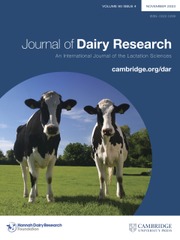No CrossRef data available.
Article contents
Evaluation of sensor measurements for early identification of clinical mastitis in an automatic milking system
Published online by Cambridge University Press: 18 September 2025
Abstract
This study aimed to identify the best automatic milking system (AMS) parameters and monitoring data for early detection of clinical mastitis in dairy cows and to determine the earliest possible detection within 30 days with the highest predictive accuracy. From August 2021 to February 2022, 55 Holstein cows were monitored for mastitis using physical examination, positive California mastitis test (CMT) and the AMS manufacturer’s software (Delpro®) criteria: milk electrical conductivity ≥ 5.37 mS/cm, milk yield ≤ 80%, somatic cell count (SCC) > 200,000 cells/mL and Mastitis Detection Index (MDi) ≥ 2.0. For every cow suspected of mastitis, two other lactating cows were randomly chosen for evaluation to provide a comparison with healthy herd companions. In total, 129 inspections were evaluated: 39 with clinical mastitis and 90 without. Data on milking, milk composition and production from the AMS, and behavioural data from monitoring collars were summarized for the 30 days leading up to the mastitis diagnosis. Thirty measurement parameters were analysed using generalized linear models. Sensitivity, specificity, accuracy, positive predictive value and negative predictive value were calculated. In the final model, significant parameters included: milk production per day (kg), SCC (cells/mL), average flow mean (kg/min), average conductivity (mS/cm), average flow peak (kg/min), average production per milking (kg), milking duration (s), rumination (min/day), panting (min/day) and feeding activity (min/day). From −30 to −10 days, accuracy, sensitivity and specificity varied without a defined pattern. However, from day −9, there was stabilization of the evaluated parameters. Results showed an average accuracy of 79.2%, a sensitivity of 82.5%, a specificity of 78.7%, a positive predictive value of 41.5% and a negative predictive value of 92.2% in predicting mastitis occurrence. In conclusion, using AMS parameters and behavioural data from monitoring collars, it was possible to predict clinical mastitis in dairy cows in an AMS with a 9-day advance notice.
Information
- Type
- Research Article
- Information
- Copyright
- © The Author(s), 2025. Published by Cambridge University Press on behalf of Hannah Dairy Research Foundation.

